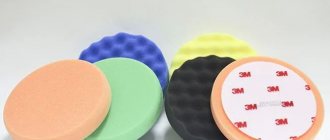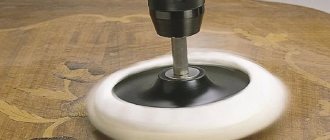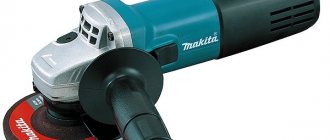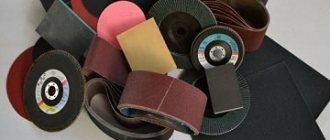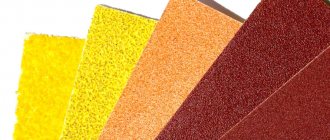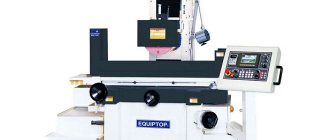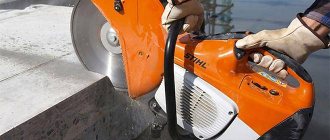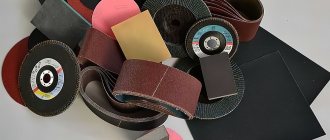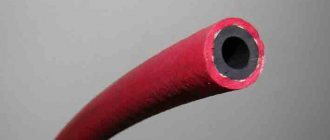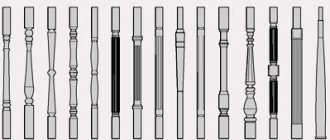Zero sandpaper is a fine abrasive sandpaper for rubbing surfaces when performing repairs and construction and finishing work. The use of one of the varieties of fine-grained, “zero” sandpaper is determined by the quality of the surface and the processing characteristics of a particular material. Smoothing out uneven surfaces, finishing sanding - for these and many other finishing processes it is necessary to use a zero.
Working with sandpaper Source static-cdn2.vigbo.tech
Main classification
The most important characteristic is the grain size of the material, which determines the scope of its application - roughing, grinding, polishing.
According to current international standards and those adopted in Russia since 2005, grain size is determined by the number of grains per square inch. Accordingly, the more grains are placed per unit area, the smaller their size. According to this standard, the grain size of the material is reflected by the letter P and a number from 12 to 2500. According to the old GOST 3647-80, often used in the CIS countries, the number indicates the grain size in tens of microns with the letter –H at the end (6-N, 16-N, 32-N, etc.). The smallest grains are measured in microns and are designated M, for example M40.
https://www.youtube.com/watch?v=LROhoVmhyzw
You can study the scope of purpose, markings and grit according to various standards in the table below. Purpose of sandpaper, grit and marking.
| Purpose | Marking according to GOST 3647-80 | Marking according to ISO-6344 | Grain size, microns | |
| Coarse-grained | ||||
| Very rough work | 80-N | P22 | 800-1000 | |
| 63-N | P24 | 630-800 | ||
| 50-N | P36 | 500-630 | ||
| Rough work | ||||
| 40-N | P40 | 400-500 | ||
| 32-N | P46 | 315-400 | ||
| 25-N | P60 | 250-315 | ||
| Primary grinding | 20-N | P80 | 200-250 | |
| 16-N | P90 | 160-200 | ||
| 12-N | P100 | 125-160 | ||
| 10-N | P120 | 100-125 | ||
| Final sanding of soft wood, old paint for painting | 8-N | P150 | 80-100 | |
| 6-H | P180 (P 220) | 63-80 | ||
| Fine-grained | ||||
| Final sanding of hardwood, sanding between coats | 5-N,M63 | P240 | 50-63 | |
| 4-N,M50 | P280 | 40-50 | ||
| Polishing final coats, sanding between coats, wet sanding | M40N-3 | P400 | 28-40 | |
| М28Н-2 | P600 | 20-28 | ||
| Grinding of metal, plastics, ceramics, wet grinding | M20N-1 | P1000 | 14-20 | |
| Even finer grinding, polishing | M14 | P1200 | 10-14 | |
| M10/N-0 | P1500 | 7-10 | ||
| М7Н-01 | P2000 | 5-7 | ||
| М5Н-00 | P2500 | 3-5 | ||
The type of abrasive is also an important indicator. The most widely used is electrocorundum, characterized by resistance to high pressure and good cutting properties. It can be produced with the addition of chromium oxide, which increases the abrasive properties and strength of the material. It can be recognized by its characteristic ruby color.
Among other grain materials, we note the following:
- Silicon carbide. Stronger than electrocorundum, but more fragile. Thanks to this, the crystals split under pressure and form new faces, thereby renewing the surface.
- Pomegranate. A relatively soft mineral, used mainly for wood processing.
- Elbor and diamond. Superhard materials. Rarely used due to high cost.
Sandpaper-zero
“Null” sandpaper is the most delicate sandpaper with the least abrasive coating. According to the international standard, such paper has a rating from P400 to P2500 and is used for final and ultra-fine grinding of coatings:
- P2500 (M5/N-00) has a grain size of 3-5 microns;
- P2000 (M7/N-01) – 5-7 microns;
- P1500 (M10/N-0) – 7-10 µm;
- P1200 (M14) – 10-14 microns;
- P1000 (M20/N-1) – 14-20 µm;
- P600 (M28/N-2) – 10-14 µm;
- P400 (M40/N-3) – 10-14 microns.
This is interesting! The grain size of the “zero” is so small that it is practically not noticeable to the touch.
Monotonous but necessary work with “zero” Source usamodelkina.ru
GOST 3647
| GOST R 52381 | GOST 3647 |
| F4 | – |
| F5 | |
| F6 | |
| F7 | |
| F8 | |
| F10 | 200 |
| F12, P12 | 160 |
| F14 | – |
| F16, P16 | 125 |
| F20, P20 | 100 |
| F22 | – |
| F24, P24 | 80 |
| F30, P30 | 63 |
| F36, P36 | 50 |
| F40, P40 | – |
| F46 | 40 |
| F54, P50 | 32 |
| F60, P60 | 25 |
| F70 | 20 |
| F80, P80 | – |
| F90, P100 | 16 |
| F100, P120 | 12 |
| F120, P150 | 10 |
| F150, P180 | 8 |
| F180, P220 | 6 |
| F220 | 5 |
Key words: abrasive materials, grinding powders, grain size, grain composition, control of grain composition
Grain composition
The grain composition of grinding powders with grain sizes from F4 to F220 must correspond to that indicated in Table 1.
1 – Grain composition of grinding powders with grain sizes from F4 to F220
| Test sieve cell size 1 W1,mm (µm) | Remaining grinding powder on control sieve 1 Q1, % | Test sieve cell size 2 W2, mm (µm) | Remaining grinding powder on control sieve 2 Q2, %, no more | Test sieve cell size 3 W3, mm (µm) | Remaining grinding powder on control sieve 3 Q3, %, not less | Test sieve cell size 4 W4, mm (µm) | Remaining grinding powder on control sieves 3 and 4 Q3Q4, %, not less | Test sieve cell size 5 W5, mm (µm) | Remaining grinding powder on control sieves 3 – 5 Q3Q4 Q5, %, not less | Remaining grinding powder on the pallet ΔQ, %, no more | |
| F4 | 8,00 | – | 5,60 | 20 | 4,75 | 40 | 4,00 | 70 | 3,35 | Not regulated | 3 |
| F5 | 6,70 | 4,75 | 4,00 | 3,35 | 2,80 | ||||||
| F6 | 5,60 | 4,00 | 3,35 | 2,80 | 2,36 | ||||||
| F7 | 4,75 | 3,35 | 2,80 | 2,36 | 2,00 | ||||||
| F8 | 4,00 | 2,80 | 2,36 | 45 | 2,00 | 1,70 | |||||
| F10 | 3,35 | 2,36 | 2,00 | 1,70 | 1,40 | ||||||
| F12 | 2,80 | 2,00 | 1,70 | 1,40 | 1,18 | ||||||
| F14 | 2,36 | 1,70 | 1,40 | 1,18 | 1,00 | ||||||
| F16 | 2,00 | 1,40 | 1,18 | 1,00 | (850) | ||||||
| F20 | 1,70 | 1,18 | 1,00 | (850) | (710) | ||||||
| F22 | 1,40 | 1,00 | (850) | (710) | (600) | ||||||
| F24 | 1,18 | (850) | 25 | (710) | (600) | 65 | (500) | ||||
| F30 | 1,00 | (710) | (600) | (500) | (425) | ||||||
| F36 | (850) | (600) | (500) | (425) | (355) | ||||||
| F40 | (710) | (500) | 30 | (425) | 40 | (355) | (300) | ||||
| F46 | (600) | (425) | (355) | (300) | (250) | ||||||
| F54 | (500) | (355) | (300) | (250) | (212) | ||||||
| F60 | (425) | (300) | (250) | (212) | (180) | ||||||
| F70 | (355) | (250) | 25 | (212) | (180) | (150) | |||||
| F80 | (300) | (212) | (180) | (150) | (125) | ||||||
| F90 | (250) | (180) | 20 | (150) | (125) | (106) | |||||
| F100 | (212) | (150) | (125) | (106) | (75) | ||||||
| F120 | (180) | (125) | (106) | (90) | (63) | ||||||
| F150 | (150) | (106) | 15 | (75) | (63) | (45) | |||||
| F180 | (125) | (90) | Not regulated | 40 | (53) | 65 | Not regulated | ||||
| F220 | (106) | (75) | (63) | (53) | (45) | 60 |
An example of a symbol for silicon carbide grinding powder with grain size F100:
Silicon carbide F100 GOST R 52381-2005
The maximum deviations of the grain composition of the grinding powder sample during interlaboratory determinations must correspond to those indicated in Table 2.
The grain composition of grinding powders with grain sizes from P12 to P220 must correspond to that indicated in Table 3.
3 – Grain composition of grinding powders with grain size from P12 to P220
| Test sieve cell size 1 W1,mm (µm) | Remaining grinding powder on control sieve 1 Q1, % | Test sieve cell size 2 W2, mm (µm) | Remaining grinding powder on control sieve 2 Q2, %, no more | Test sieve cell size W3, mm (µm) | Remaining grinding powder on control sieves 1 – 3 Q3, %, not less | Test sieve cell size 4 W4, mm (µm) | Remaining grinding powder on control sieves 1 – 4 Q4, % | Test sieve cell size 5 W5, mm (µm) | Remaining grinding powder on control sieves 1 – 5 Q3, %, not less | Remaining grinding powder on the pallet ΔQ, %, no more | |
| P12 | 3,35 | – | 2,36 | 1 | 2,00 | 14 ± 4 | 1,70 | 61 ± 9 | 1,4 | 92 | 8 |
| P16 | 2,36 | 1,70 | 3 | 1,40 | 26 ± 6 | 1,18 | 75 ± 9 | 1,0 | 96 | 4 | |
| P20 | 1,70 | 1,18 | 7 | 1,00 | 42 ± 8 | (850) | 86 ± 6 | (710) | |||
| P24 | 1,40 | 1,00 | 1 | (850) | 14 ± 4 | (710) | 61 ± 9 | (600) | 92 | 8 | |
| P30 | 1,18 | (850) | (710) | 14 ± 4 | (600) | (500) | |||||
| P36 | 1,00 | (710) | (600) | 14 ± 4 | (500) | (425) | |||||
| P40 | (710) | (500) | 7 | (425) | 42 ± 8 | (355) | 86 ± 6 | (300) | 96 | 4 | |
| P50 | (600) | (425) | 3 | (355) | 26 ± 6 | (300) | 75 ± 9 | (250) | |||
| P60 | (500) | (355) | 1 | (300) | 14 ± 4 | (250) | 61 ± 9 | (212) | 92 | 8 | |
| P80 | (355) | (250) | 3 | (212) | 26 ± 6 | (180) | 75 ± 9 | (150) | 96 | 4 | |
| P100 | (300) | (212) | 1 | (180) | 14 ± 4 | (150) | 61 ± 9 | (125) | 92 | 8 | |
| P120 | (212) | (150) | 7 | (125) | 42 ± 8 | (106) | 86 ± 6 | (90) | 96 | 4 | |
| P150 | (180) | (125) | 3 | (106) | 26 ± 6 | (90) | 75 ± 9 | (75) | |||
| P180 | (150) | (106) | 2 | (90) | 15 ± 5 | (75) | 62 ± 12 | (63) | 90 | 10 | |
| P220 | (125) | (90) | (75) | 15 ± 5 | (63) | (53) |
An example of a symbol for silicon carbide grinding powder with P80 grit:
Silicon carbide R80 GOST R 52381-2005
How to choose sandpaper?
For grinding machines, there are special sandpapers of various shapes (circle, triangle, rectangle) with a Velcro base. Such paper does not lose its shape for a long time and is suitable for long-term and continuous use. They are very easy to replace and are available for free sale in any construction department.
The most common type is paper-based sandpaper. This is what is most often found in home workshops. The paper base goes through special stages of processing and impregnation to maximize strength and moisture resistance.
The mesh for grouting putty is marked identically to paper: the larger the number, the smaller the abrasive particle. The degree of sanding is chosen depending on what subsequent action will be performed on the putty. The walls are sanded manually or using special machines. For manual application, use a kind of grater, onto which a piece of mesh is attached and evenly passed over the desired area.
The sandpaper on the sponge will help you reach hard-to-reach areas. It also makes it easier to clean parts of complex shapes. The sponge can be hard or soft. The hard one is used for flat surfaces, the soft one for curly surfaces.
Sandpaper for grinding machines
Sandpaper for grinding machines Find out
There are different types of sanders; a power belt tool can be used to sand wooden surfaces.
Carrying out work using equipment requires the correct selection of skins. Sandpaper for grinding machines is presented in the form of triangles, tapes of various widths, round sandpaper with a Velcro surface, roll, or sheet for mechanisms.
The grain size is selected depending on the type of work performed. “Nulevka” sanding material is intended for final polishing of the surface. It is important to remember safety precautions, no matter what the grit size of the sandpaper. Always sand with safety glasses, a respirator and gloves.
Control of grain composition
The essence of control
The essence of the control is to determine the content of grinding powder residues as a percentage of the weight of the test sample, equal to 100 g, obtained by sieving on a set of control sieves.
Equipment
Machine for sieving samples of grinding powders type RO-TAP.
A machine for sieving samples of grinding powders is shown in Figure 1.
Type A Type B
– shaker; 2 – plug; 3 – test sieves; 4 – pallet; 5 – base plate; 6 – base
The machine must be equipped with a time switch.
A type A machine must be secured with three M10 bolts on a concrete base plate measuring 625 x 500 x 550 mm with a mass that prevents the transmission of vibration to it.
The concrete base slab should be installed on a vibration-absorbing pad made of hard felt to level out uneven ground conditions.
Machine Feature:
rotation speed – (285 ± 10) min-1;
the number of strikes of the striker in the center of the cover is (15 ± 10) per minute.
A set of test sieves according to GOST R 51568 with cell side dimensions:
(8.00 ± 0.25), (6.70 ± 0.21), (5.60 ± 0.18), (4.75 ± 0.15), (4.00 ± 0.13), (3.35 ± 0.11), (2.80 ± 0.09), (2.36 ± 0.08), (2.00 ± 0.07), (1.70 ± 0.06), (1.40 ± 0.05), (1.18 ± 0.04), (1.00 ± 0.033) mm;
(850 ± 29), (710 ± 25), (600 ± 21), (500 ± 18), (425 ± 16), (355 ± 13), (300 ± 12), (250 ± 9.9), (212 ± 8.7), (180 ± 7.6), (150 ± 6.6), (125 ± 5.8), (106 ± 5.2), (90 ± 4.6), (75 ±4.1), (63 ± 3.7), (53 ± 3.4), (45 ± 3.1) µm.
Test sieves should not have visible defects: ruptures, thickening, blockages of cells, mesh tension, as well as distortions of the frame (shell), soldering defects.
A set of test sieves should be used for the specific grit size of the abrasive powder sample.
The frame (shell) of the test sieve should have a diameter of 200 mm and a height of 50 mm.
Checking test sieves
Checking of control sieves, controlled grinding powders for the manufacture of abrasive tools, excluding tools on a flexible basis, is carried out according to GOST R 51568.
Verification of control sieves, controlled grinding powders for the manufacture of abrasive tools on a flexible basis is carried out using standard samples as follows:
The control sieve to be verified is installed third in the set of control sieves. The first and second sieves must be checked. The standard sample is sieved on a set of control sieves. If the sum of the percentage residues on control sieves 1, 2 and 3 differs from the tolerances specified in Table 3 by more than 1.5 times, then the control sieve subject to verification is considered unsuitable for use.
The control sieve subject to verification, which cannot be installed third in the set of control sieves, is installed fourth in the set of control sieves. The first, second and third sieves must be checked.
The standard sample is sieved on a set of control sieves. If the sum of the percentage residues on control sieves 1, 2, 3 and 4 differs from the tolerances specified in table 3 by more than 1.5 times, then the control sieve subject to verification is considered unsuitable for use.
Test sieves with cell side sizes of 3.35, 2.36 mm and 53 microns are verified according to GOST R 51568.
The frequency of checking control sieves is once every six months.
Scales with an accuracy of ±0.1 g.
Time relay with an error of ± 5 s.
Standard samples of grinding powders for tools on a flexible basis according to a document approved in the prescribed manner.
Marking of sandpaper depending on its purpose: table
Depending on the specifics of the work, coarse sandpaper is divided into several main groups:
| Marking | Types of jobs |
| P22; P24;P36 | Preparatory work: removing rust Elimination of large surface defects |
| 80-N; 63-N; 50-N | |
| P40; P46; P60 | Rough surface treatment |
| 40-N; 32-N; 25-N | |
| P80; P90; P100; P120 | Pre-grinding |
| 20-N; 16-N; 12-N; 10-N | |
| P150; P180 | Final sanding and finishing |
| 8-H; 6-H |
Fine-grained sandpaper is also marked according to the features of use:
| Marking | Types of jobs |
| P240; P280 | Sanding hardwood |
| 5-H; M63 | |
| P400; P600 | Polishing surface preparation for painting |
| M28; M40; 2-H; 3-H | |
| Р1000 | Grinding of ceramic surfaces, plastics and metals |
| M20; 1-H | |
| P1200; P1500; P2000; Р2500 | Polishing and deglazing |
| M14; M10; M7; M5; N-0;N-00; N-01 |
When purchasing sandpaper, you may find other markings on the back side. Each of them carries a certain meaning, for example, the type of abrasive powder, the method of its attachment, the characteristics of the adhesive mixture and the type of base and its mechanical properties. Let's look at the basic notation.
- The name “P” indicates the abrasive structure of the material;
- The letter “L” denotes the form of release, in this case – sheet;
- The numbers “1” and “2” indicate the purpose of the abrasive cloth: 1 – for grinding soft surfaces, 2 – metal and other hard and especially hard materials;
- Resistance to moisture is indicated by the symbols “L1”, “L2” or M;
- The designation “P” indicates that exposure to moisture and dampness is extremely undesirable.
In addition to these designations, special attention must be paid to the properties of the abrasive particles themselves.
Characteristics and types of sandpaper
Sandpaper
The correct choice of sandpaper should take into account the optimal parameters for purpose, type of abrasive, application method, grain size and water resistance, marking. Previously, grinding sandpaper was made from organic components, and was a mixture of corundum and magnetite. Today, the manufacturing material is aluminum oxide, garnet, or synthetic diamond.
Sandpaper for wood has many varieties that are used in the finishing process. It is important to pay special attention to the choice of material parameters to achieve the desired sanding result. The product range is presented in the form of sheets, rolls, open, closed options, commercial or industrial use.
Types of abrasive
Sandpaper for wood differs in the abrasive components applied to the base:
- electrocorundum;
- silicon carbide;
- pomegranate;
- synthetic diamond.
Electrocorundum types of sandpaper are distinguished by a high degree of rigidity and are resistant to pressure due to the hardness of the crystals. The material has excellent cutting properties. They are used at the stage of rough finishing of wood.
It is advisable to use sandpapers based on silicon carbide when grinding glass, plastic, or finishing wood. Small abrasive particles are fragile and crumble under pressure. The alloy is made from silica and graphite.
A very brittle garnet abrasive will help to sand wooden surfaces to a smooth structure. Small particles allow you to achieve excellent results. Diamond-based abrasive has a high level of hardness and durability. Rarely used due to its high cost.
Application technology
Sandpaper for wood processing is selected taking into account the technology of applying abrasive material to the base:
- Mechanical view. The application of the force of gravity allows particles to be applied to the base in a chaotic manner. The result obtained is not aggressive.
- Electrostatic method. The sharpness of the layer is achieved by using an electrostatic field to direct negatively charged particles. The result is a very sharp layer.
- On adhesive bases and resins. The material has excellent characteristics that increase the performance of the sanding layer (antistatic additives, dirt-repellent substances).
- With the use of binding components. The technology involves the introduction of additional binding particles, which significantly increase the strength of the material.
Sanding the surface of the array with sandpaper to achieve a matte finish is done with a fibrous sandpaper based on a non-woven mesh material impregnated with resins and an abrasive composition.
Sandpaper grit for wood
Coarse sandpaper
The material is used based on the type of grit. The level of this indicator determines the type of surface treatment performed. Sandpaper grit:
- 40-60 (rough, rough work);
- 80-120 (eliminates unevenness);
- 150-180 (final stage of processing);
- 220-240 (grouting process);
- 280-320 (gets rid of stains before painting);
- 360-600 (sand the surface).
The choice of material depends on the type of processing required. Too fine a grain of sandpaper should not be used for wood processing.
Labeling Standards
Types of sandpaper for wood and their characteristics largely depend on the country of manufacture. The markings allow you to navigate which sandpaper is best to use. There are several main foreign groups: USA, Canada, Japan and China. The FEPA standard is generally accepted and corresponds to the Russian system.
The grit index indicates the ratio of the amount of abrasive on the blade. The larger the grains, the fewer there are on the canvas. The low grit version is intended for roughing. A high grain size indicates the fine nature of the particles, which makes it possible to perform the process of polishing, or sanding the wood with sandpaper.
Water resistance
The water resistance rating will help determine which sandpaper to use for wood. A material with a high level of resistance to moisture is used for industrial woodworking in the field of furniture production.
Additionally, before sanding the wood, the emery is soaked in water to achieve the necessary elasticity. Sandpaper of this type is made on the basis of special resins and fabric, with varying degrees of grain size. The waterproof material is presented in a wide range of types, which allows the skin to be used at any stage of wood processing.
Sanding paper marking[ | ]
For example, paper-based abrasives[1]
| L 1 E 620×50 P2 15A 25-N M A GOST 6456—82 622 |
Where:
- L - sheet does not put the letter for roll
- 1 - paper type. Options: 1 - for grinding low-hardness materials
- size, width, mm x length, mm for sheets
- L1, L2, M - moisture-resistant paper
- 15A - normal electrocorundum
- M63 ... M3 - micro-grinding powders, size in microns
- GOST 13344-79 - waterproof fabric
Paper-based abrasives
[source not specified 278 days]
The base paper must be very strong to withstand mechanical stress. It is classified depending on density (g/m2) and marked with colored letters. This classification is accepted (according to FEPA).
The paper can be either waterproof or regular. Pay attention to the manufacturer's markings. The water resistance of sanding paper is also determined by the type of binder.
Advantages of paper base:
- low cost;
— the base does not lengthen during operation;
— the surface allows the application of the smallest fractions of abrasive material.
Flaws:
— low strength and wear resistance;
— non-waterproof (waterproof paper base is used, as a rule, only for manual processing).
Fabric based abrasives
[source not specified 278 days]
Most often, cotton and polyester are used as the basis for abrasive materials. The fabrics are impregnated with polyester resin to give them greater strength and water resistance. The main characteristics of fabrics are elasticity and tensile strength.
Class J cloth is used for fine sanding of edges and profiles. Fabric X is usually used for dirty heavy work. Fabrics of types W and Y are used when increased belt strength is required - for industrial sanding of panels. When choosing a fabric-based tape, you should always choose a type as hard as the grinding operation and the shape of the surface being processed allow. The rigidity of the base most often directly correlates with the service life of the tape.
Advantages of fabric base:
— high strength and wear resistance;
- water resistance.
Flaws:
- relatively high cost;
— elongation during operation (depending on the type of fabric and the nature of processing).
For the production of some abrasive materials, combined bases are used
(fabric glued to paper) with different properties.
Fiber base
- a special type of base intended for the manufacture of fiber discs. Fiber is produced by treating cellulose with zinc chloride, resulting in a completely new, hard and dense product. The base is non-waterproof and actively absorbs moisture.
Classification of sanding paper by type of abrasive application (coating)
[source not specified 278 days]
Open and semi-open filling: grains cover from 40 to 60% of the surface of the base. This type of filling is suitable for processing loose, soft materials - soft, resinous wood, putty surfaces, etc. The open type of filling eliminates clogging of the spaces between the grains with grinding waste and the formation of lumps on the abrasive surface.
Closed or continuous coating: the abrasive grains completely cover the surface of the substrate. Solid-fill abrasives are more effective when sanding hard materials (metals, hard woods).
Features of sandpaper manufacturing
The abrasive, which is the working part of the scratch, can be applied to a base of different composition. For example, on paper or fabric. The history of the production of any sandpaper goes back to ancient origins, which date back to the thirteenth century. At the same time, the first mentions of such material appeared in China. Previously, specialists in the production of sandpaper of different grain sizes added crushed shell rock, seeds of various plants, an adhesive composition, as well as agar-agar or starch for the gluing effect.
Making sandpaper Source kak-sdelano.ru
The paper base of the sandpaper gives a low level of wear resistance and water resistance, and is marked as follows: P1, P2, P3 and so on (an example of GOST product marking is given). The fabric base of the sandpaper (fabric-based sandpaper) guarantees increased durability and does not allow the product to crumble after the first serious processing of various non-smooth surfaces. Not only a more durable base made of natural cotton or artificial polyester helps here, but also the presence of a special resin impregnation. Wet-resistant paper is designated for sandpaper with different abrasive abilities as the letter “L”.
Also important for scratch sandpaper with a grain size of 400-2500 (according to the international method for determining the abrasiveness of this grouting material) is the method of applying the active surface to the base. This can be an open or closed method. In the first case, the user receives sanding paper with a half-covered base; in the second, the base lining is completely covered with abrasive material.
Processing of control results
The percentage content of grinding powder residues for the manufacture of abrasive tools (except for tools on a flexible basis) on control sieves is determined by dividing the mass of the grinding powder residue on control sieves by the weight of the test sample of grinding powder.
A sample of grinding powder complies with this standard if the percentage of remaining grinding powder of controlled grain size on the control sieves is within the limits specified in Table 1.
If not, then re-check the grain composition of the grinding powder using twice the number of samples.
When monitoring grinding powders for the manufacture of tools on a flexible basis, taking into account the presence of deviations between control sieves of the same size, determine the difference in the residual values of the standard sample sample according to the document and on the set of sieves used Δq.
Determine the value of the residue of the tested grinding powder q.
The percentage content of grinding powder residues for the manufacture of abrasive tools on a flexible basis on control sieves is determined by dividing the adjusted mass of grinding powder residue on control sieves (the difference between q and Δq) by the weight of the test sample of grinding powder.
A sample of grinding powder for tools on a flexible basis complies with this standard if the adjusted mass of the remaining grinding powder of controlled grain size on the control sieves is within the limits specified in Table 3. If not, then re-check the grain composition of the grinding powder on a double number of samples.
An example of recording the results of monitoring the grain composition of grinding powder with a grain size of P80 is given in Appendix A.
The approximate correspondence of grain sizes according to this standard and according to GOST 3647 is given in Appendix B.
Briefly about the main thing
Zero sandpaper is one of the many types of sanding or sanding finishing paper.
Zeroing is used in construction and finishing works, as well as in the production of piece (single) or flow (factory) products of different editions.
Sandpaper (except for grit) can be fabric, paper or a combination (depending on the base on which the abrasive material is applied).
According to state Russian and international standards, different sandpaper is manufactured under different (corresponding to the type) markings, which may contain both numbers and letters.
You can determine which sandpaper is in front of you by looking at the markings on the packaging or by touching the working surface of the material.
Features of application
Sandpaper clamp
- When processing the surface, you should adhere to the general rule: start work using coarser sanding paper, gradually replacing it with paper with a finer grain (higher grain size). Coarse and very coarse grains are used for rough sanding of wood, removing old paint and rust from metal surfaces. Fine and very fine grain - for different stages of fine grinding, sanding, polishing painted surfaces, metal grinding. For plastic, sanding paper coated with silicon carbide is successfully used.
- For wet sanding, waterproof sanding paper with grit P400-P600 is usually used. Using water when sanding allows you to achieve a smoother surface and eliminates the formation of dust. Wet sanding is usually done by hand to carefully control the force applied.
- Nowadays, not only traditional paper and cloth-based sanding sheets are available for hand and machine sanding, but also attachments that are best suited for some specific needs and facilitate the processing of difficult surfaces or loose bulk materials.
- It is recommended to clean copper lamellas of electric motor commutators from carbon deposits only with glass sandpaper; any other will leave its grains on the surface of the copper and cause the carbon or graphite brushes to quickly grind off. The popular way is to use the “striking” surface (grater) of a matchbox containing glass dust for this.
- For manual sanding of large curved surfaces, it is convenient to attach sandpaper to a thick (about 1 cm) piece of soft rubber.
- To make it easier to work with sandpaper, it is wrapped around a block (made of any material - wood, plastic, foam) with a piece of felt or porous rubber attached (nailed, glued) to it.
the quality of manual work with pressure control is combined with increased productivity
- As fine sandpaper for plastics, you can use coarse paper (wrapping paper or newspaper without text).
Areas of application of zero sandpaper
Nulevka sandpaper has been successfully used for a long time in the construction and repair industry, as well as in the manufacture of furniture, interior accessories and other parts. It is worth listing several areas of application of this material:
- furniture;
- carpentry;
- paintwork;
- automotive repair industry;
- industrial;
- finishing;
- mechanical engineering;
- construction;
- instrument making;
- production of specialized industry equipment, fixtures and instruments (including non-standard, manual and machine ones).
It is important! “Nulevka” can be produced in both sheet and roll form.
Table of sandpaper grit types
| Application | Grain size, microns | ISO 6344 marking | Marking GOST 3647-80 |
| Fine grain | |||
| Finishing hardwood | 50-63 | R 240 | 5-N, M63 |
| 40-50 | R 280 | 4-N, 50M | |
| Sanding before painting, wet leveling | 28-40 | R 400 | M40/N-3 |
| 20-28 | R 600 | M28/N-2 | |
| Plastic, glass, ceramics | 14-20 | R 1000 | M20/N-1 |
| High gloss polishing of all types of materials | 10-14 | R 1200 | M14 |
| 7-10 | R 1500 | M10/N-0 | |
| 5-7 | R 2000 | M7/N-01 | |
| 3-5 | R 2500 | M5/N-00 | |
| Coarse grain | |||
| Corrosion removal, burr treatment | 800-1000 | R 22 | 80-N |
| 630-800 | R 24 | 63-n | |
| 500-630 | R 36 | 50-N | |
| Rough woodwork | 400-500 | R 40 | 40-N |
| 315-400 | R 46 | 32-N | |
| 250-315 | R 60 | 25-N | |
| Stripping wood fibers, removing plaster, putty | 200-250 | R 80 | 20-N |
| 160-200 | R 90 | 16-N | |
| 125-160 | R 100 | 12-N | |
| 100-125 | R 120 | 10-N | |
| Removing protective coatings | 80-100 | R 150 | 8-N |
| 63-80 | R 180 | 6-H | |
General information about sandpaper
Sandpaper or sandpaper is a carpentry abrasive applied to a fabric or other flat thin base, which is intended for machine or manual processing of metal, wood, and ceramic surfaces. This material is made by impregnating the base with polymers, then applying heated glue and abrasives of the required fraction (required size). After drying in an oven at a certain temperature, the sanding paper becomes suitable for use.
Since sandpaper can be made rough or almost smooth, special markings are used for convenience. Previously, this parameter was determined according to the GOST 3647-80 standard, which determines the grain size of the sandpaper (the number of grains of different sizes per square unit of sandpaper area). Nowadays, international ISO standards are used, which still have something in common with the old state (domestic) ones.
According to modern rules, grain size is designated using the letter “P”. A number is placed next to it, by which the size of the “grains” is determined: the larger the numerical designation, the finer the sandpaper.
Correspondence table between foreign and domestic markings of sandpaper Source derevo-s.ru
For the GOST designation, other markings apply. Before the letter there is a number that indicates the size of the sieve with a certain side of the mesh. For example, the “grain” of “10-N” sandpaper corresponds to a sieve with a mesh size of 10 microns. The opposite rule applies here: the lower the indicator, the smaller the crop size.
See also: Catalog of companies that specialize in finishing materials and related work
Sanding with sandpaper
It has already been noted that the described material is required in many areas of activity:
- construction and finishing: processing putty surfaces in order to level them and get rid of small grooves from a spatula or sagging, stripping various materials (metal, wood, PVC) from old coating;
- car repair: performing various types of body work (removing traces of corrosion, treating the base before puttying and its subsequent leveling, sanding before painting, applying varnish, matting the surface before priming and other types of work);
- woodworking: sanding wood, obtaining a uniform surface, processing water-based paints and varnishes;
- painting work: treating bases before and after applying paint, smoothing out smudges;
- furniture repair and production.
Many home craftsmen find very original ways to solve certain problems. Here are some of them using skins “inappropriately”.
- Cleaning the seams between tiles. Stubborn stains in the spaces between tiles can be very difficult to remove using cleaning products. To do this, some craftsmen advise using a sheet of fine-grained sandpaper bent in half. The grout should be handled with great care, being careful not to damage the tile itself.
- Sharpening needles. This area of application will be appreciated by needlewomen. To return the needle to its former sharpness, simply pierce the sandpaper with it several times, or “wrap” the tip in sandpaper and rotate it briefly.
- Update your cutting board. Over time, wooden cutting boards become riddled with a fine network of knife grooves. This does not easily spoil the appearance of the product, but it is also very unhygienic, because such a surface is a “paradise” for bacteria and microbes. To level the base, you just need to use sandpaper.
- "Repair" of suede. Light abrasions and dirt from suede items can be removed with sandpaper. You should carefully walk it in places that require cleaning, and then “comb” it with a brush to return the pile to its place.
This is not a complete list of areas for using sandpaper, but it is impressive. The little things really add up to something bigger than what meets the eye.
General rules for using sandpaper
Sandpaper for grinding, that is, zero (as well as other abrasive versions of sandpaper) is used with a base of different processing techniques. So, when marked with the letter “J”, it becomes clear that such sandpaper should be used for grinding the edge or profile. Heavy work with a high degree of contamination is carried out using material with the letter “X”.
As for letters such as “W” and “Y”, which are used for marking, they signal to the user that this product has a higher level of strength and is suitable for a stronger impact.
This is interesting! The basic rule for choosing a suitable sandpaper (including from the “zero” line) remains the rule of moving from the minimum grain size to the maximum.
